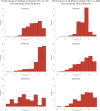Abnormal Cerebral Perfusion Profile in Older Adults with HIV-Associated Neurocognitive Disorder: Discriminative Power of Arterial Spin-Labeling
- PMID: 30467218
- PMCID: PMC6748330
- DOI: 10.3174/ajnr.A5902
Abnormal Cerebral Perfusion Profile in Older Adults with HIV-Associated Neurocognitive Disorder: Discriminative Power of Arterial Spin-Labeling
Abstract
Background and purpose: The aging HIV-infected (HIV+) population has increased vascular comorbidities, including stroke, and increased cognitive deficits compared with the general population. Arterial spin-labeling is a technique to measure cerebral blood flow and is more sensitive than regional volume loss in assessing neurodegenerative diseases and cognitive aging. Previous studies have found global cerebral perfusion abnormalities in the HIV+ participants. In this study, we evaluated the specific regional pattern of CBF abnormalities in older HIV+ participants using quantitative whole-brain arterial spin-labeling.
Materials and methods: CBF data from the UCSF HIV Over 60 Cohort and the Alzheimer Disease Neuroimaging Initiative were retrospectively evaluated to identify 19 HIV+ older adults, all with plasma viral suppression (including 5 with HIV-associated neurocognitive disorder); 13 healthy, age-matched controls; and 19 participants with early mild cognitive impairment. CBF values were averaged by ROI and compared among the 3 groups using generalized linear models.
Results: When we accounted for age, education, sex, and vascular risk factors, the HIV+ participants demonstrated alterations in regional cerebral perfusion, including hypoperfusion of bilateral temporal, parietal, and occipital brain regions compared with both clinically healthy participants and those with mild cognitive impairment. Arterial spin-labeling showed reasonable test characteristics in distinguishing those with HIV-associated neurocognitive disorder from healthy controls and participants with mild cognitive impairment.
Conclusions: This study found specific CBF patterns associated with HIV status despite viral suppression-data that should animate further investigations into the pathobiologic basis of vascular and cognitive abnormalities in HIV-associated neurocognitive disorders.
© 2018 by American Journal of Neuroradiology.
Figures



Similar articles
-
Pattern of cerebral hyperperfusion in Alzheimer's disease and amnestic mild cognitive impairment using voxel-based analysis of 3D arterial spin-labeling imaging: initial experience.Clin Interv Aging. 2014 Mar 26;9:493-500. doi: 10.2147/CIA.S58879. eCollection 2014. Clin Interv Aging. 2014. PMID: 24707173 Free PMC article.
-
Head-to-Head Visual Comparison between Brain Perfusion SPECT and Arterial Spin-Labeling MRI with Different Postlabeling Delays in Alzheimer Disease.AJNR Am J Neuroradiol. 2017 Aug;38(8):1562-1568. doi: 10.3174/ajnr.A5238. Epub 2017 Jun 1. AJNR Am J Neuroradiol. 2017. PMID: 28572147 Free PMC article.
-
Longitudinal Cerebral Blood Flow Changes in Normal Aging and the Alzheimer's Disease Continuum Identified by Arterial Spin Labeling MRI.J Alzheimers Dis. 2021;81(4):1727-1735. doi: 10.3233/JAD-210116. J Alzheimers Dis. 2021. PMID: 33967053 Free PMC article.
-
Recent advances in arterial spin labeling perfusion MRI in patients with vascular cognitive impairment.J Cereb Blood Flow Metab. 2023 Feb;43(2):173-184. doi: 10.1177/0271678X221135353. Epub 2022 Oct 25. J Cereb Blood Flow Metab. 2023. PMID: 36284489 Free PMC article. Review.
-
A neuroradiologist's guide to arterial spin labeling MRI in clinical practice.Neuroradiology. 2015 Dec;57(12):1181-202. doi: 10.1007/s00234-015-1571-z. Epub 2015 Sep 9. Neuroradiology. 2015. PMID: 26351201 Free PMC article. Review.
Cited by
-
Regional Brain Recovery from Acute Synaptic Injury in Simian Immunodeficiency Virus-Infected Rhesus Macaques Associates with Heme Oxygenase Isoform Expression.J Virol. 2020 Sep 15;94(19):e01102-20. doi: 10.1128/JVI.01102-20. Print 2020 Sep 15. J Virol. 2020. PMID: 32669339 Free PMC article.
-
Reduction in cerebral oxygen metabolism in subcortical regions may be a biomarker of cognitive decline in people living with human immunodeficiency virus.Eur J Neurol. 2022 Apr;29(4):1062-1074. doi: 10.1111/ene.15196. Epub 2021 Dec 10. Eur J Neurol. 2022. PMID: 34821434 Free PMC article.
-
Neuroimaging advances in neurocognitive disorders among HIV-infected individuals.Front Neurol. 2025 Feb 13;16:1479183. doi: 10.3389/fneur.2025.1479183. eCollection 2025. Front Neurol. 2025. PMID: 40017532 Free PMC article. Review.
-
HIV Promotes Neurocognitive Impairment by Damaging the Hippocampal Microvessels.Mol Neurobiol. 2022 Aug;59(8):4966-4986. doi: 10.1007/s12035-022-02890-8. Epub 2022 Jun 4. Mol Neurobiol. 2022. PMID: 35665894 Free PMC article.
-
Association of Apolipoprotein E4-related Microvascular Disease in the Alzheimer's Disease Hippocampal CA1 Stratum Radiatum.Neuroscience. 2023 Aug 21;526:204-222. doi: 10.1016/j.neuroscience.2023.06.019. Epub 2023 Jun 28. Neuroscience. 2023. PMID: 37385335 Free PMC article.
References
Publication types
MeSH terms
Substances
Grants and funding
LinkOut - more resources
Full Text Sources
Molecular Biology Databases
